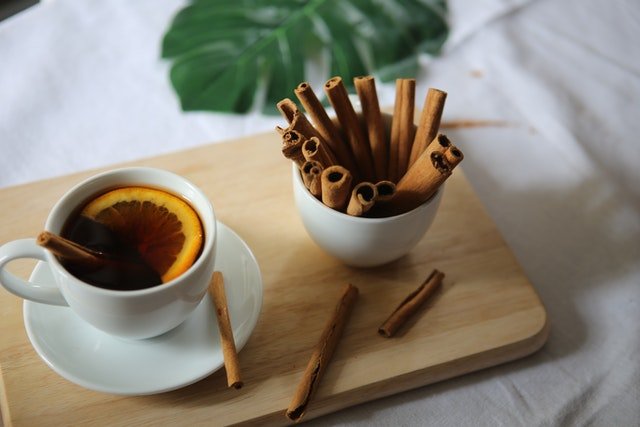
Red tea with cinnamon is one of those classic infusions that you have surely tried before and, if you haven’t, what are you waiting for? It is tasty, comforting, aromatic and beneficial for health, what more could you ask for?
As you well know, Ayurveda medicine has used spices for thousands of years to combat all kinds of diseases and ailments. One of the most used is cinnamon, with its unmistakable aroma and flavor, in addition to its enormous range of health properties.
Health benefits of red tea with cinnamon
Does red tea with cinnamon serve to lose weight?
Like green tea, it is attributed slimming properties due to the acceleration of metabolism. In addition, being rich in antioxidants, it would prevent cardiovascular disorders, including risk diseases such as heart attacks. This effect is increased by the combination with cinnamon, which also provides an interesting dose of antioxidants, as well as anti-inflammatory, antidiabetic and antimicrobial compounds.
The properties of the pu’er
Pu-erh , like other teas, has high antioxidant potential; that is to say that it is capable of protecting the organism from the damage of free radicals. In this way, it could have properties to prevent the appearance of cancer. One study, for example, has shown that red tea has an anticancer effect, while another concluded that drinking this infusion could prevent tumors from continuing to grow.
On the other hand, the fermentation process generates puerines in this tea, components that reduce cholesterol and blood sugar levels.
However, this is not all: research carried out in Yunnan concluded that tea could mitigate osteoporosis, and another from Jilin University found that pu-erh acts as a neuroprotector.
The properties of cinnamon
Famous for its health properties, cinnamon, a spice obtained from the Cinnamomum tree, is commonly used in all kinds of sweet preparations and, especially, highly valued in confectionery.
At the health level, various studies have shown that it has antioxidant, antimicrobial, anti-inflammatory, immunomodulatory and cholesterol-lowering properties. For this reason, its inclusion in the usual diet is usually recommended.
What is red tea?
Red tea or pu-erh is obtained from the leaves of the tea plant, Camellia sinensis, but these are subjected to a fermentation process that gives it its characteristic color, flavor and aroma.
It’s worth noting that if you ever travel to China, Japan, Taiwan, Korea, and other Asian countries and order red tea, you’ll probably be served black tea. As you read, black tea is called red tea in those places. For this reason, we recommend using the name pu-erh to avoid confusion.
Now, how is red tea made? After the tea tree leaves are harvested, they undergo a short oxidation process, after which they are dried in a wok over open fires. By “killing the green”, as the Chinese call it, oxidation is stopped and the essential oils of the tea are maintained.
Then, once toasted, the leaves are rolled, rubbed and worked into strips that are left to dry in the sun. Once dried, the leaves can be pressed to obtain the famous pu-erh bricks or consumed as they are.
If you want to obtain a matured pu-ehr, the fermentation of the maocha begins (this is what the already treated leaves are called). Bacteria, yeasts and molds act on it for days, months and even years. As you read, fermentation can take years or decades, depending on the flavors you want to obtain.
When fermented, the leaves acquire a brown color that transforms into the bright red that we know when infusing. Once fermentation is complete, the tea can be consumed or stored under controlled conditions to age. It is worth noting that the teas with the longest maturation processes are the most expensive and of the highest quality.
The taste of pu-erh
The flavors of red tea vary depending on the treatment of the leaves. Aromas of earth and forest or moldy wood are usually found. The bodies are usually dense.
Pu-erh is a tea with a strong character, easy to identify and differentiate. After all, fermentation is not such a common process in the world of tea.
The origin of red tea with cinnamon
We have not found data on the origin of this popular infusion. Probably, as everything in the tea world has happened (or almost everything), this mixture is due to chance. Much of the great teapot discoveries have been due to accidents.
In fact, it is said that tea was discovered when leaves fell into water that had been boiled under a mysterious tree. For this reason, it would not be strange that red tea with cinnamon was born thanks to an oversight. Although, it could also be due to Ayurveda medicine and the attempt to enhance the benefits of two components with many health benefits.
How to make the perfect cup of red tea with cinnamon

The procedure for making your red tea with cinnamon will vary depending on the form of pu-erh you wish to use. If you have red tea leaves at home, the preparation is as simple as infusing 3 grams of leaves and half a teaspoon of cinnamon in water at 90ºC for 5 minutes. Then strain and enjoy.
In the case of pu-erh cakes or bricks, before infusing, you should scrape off a small piece of 3 grams and soak it in hot water for a few seconds. Once the leaves are hydrated, discard the water and infuse the tea together with the cinnamon as we have indicated in the previous paragraph.
Take advantage of red tea with cinnamon to enjoy a powerful, full-bodied and highly aromatic flavor, in addition to benefiting from its large number of health properties.
